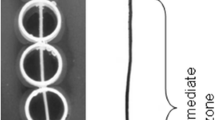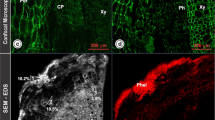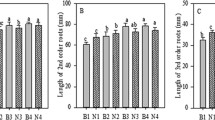Abstract
In order to investigate if Al resistance in Norway spruce (Picea abies[L.] Karst.) can be attributed to similar exclusion mechanisms as they occur in several crop plants, three-year-old Norway spruce plants were treated for one week in hydroculture with either 500 μM AlCl3 or CaCl2 solutions at pH 4. Sequential root extraction with 1 M NH4Cl and 0.01 M HCl and EDX microanalysis revealed that Al and Ca in cell walls and on the surface participated in exchange processes. About half of the Al extracted by the sequential extraction was not exchangeable by 1 M NH4Cl. Phenolics and phosphate present in the root extracts are possible ligands for Al adsorbed to or precipitated at the root in a non-exchangeable form. In both treatments, C release during the first period of 2 d was much higher than during the remaining time of the experiment. Al treated plants released less total C, carbohydrates and phenolics than did Ca treated plants. Acetate was the only organic acid anion that could be detected in some samples of both treatments. Free amino acids were present at micromolar concentrations but as hydrolysis did not increase their yield, there was no evidence of peptide release. One to two thirds of the released C were large enough not to pass a 1 kDa ultrafilter. The results suggest that exudation of soluble organic complexors is not a major Al tolerance mechanism in Norway spruce, although complexation of Al by phenolic substances released by the root could be detected by fluorescence spectroscopy. Aluminium tolerance could rather be attributed to immobilization in the root apoplast, where strong binding sites are available or precipitation may occur.
Similar content being viewed by others
References
Allen G 1981 Sequencing of proteins and peptides. Laboratory techniques in biochemistry and molecular biology. North-Holland, Amsterdam. 327 p.
Basu U, Basu A and Taylor G J 1994 Differential exudation of polypeptides by roots of aluminum-resistant and aluminum-sensitive cultivars of Triticum aestivum L. in response to aluminum stress. Plant Physiol. 106, 151–158.
Basu U, McDonald-Stephens J L, Archambault D J, Good A G, Briggs K G, Taing-Aung and Taylor G J 1997 Genetic and physiological analysis of doubled-haploid, aluminium-resistant lines of wheat provide evidence for the involvement of a 23 kD, root exudate polypeptide in mediating resistance. Plant Soil 196, 283–288.
Bauch J and Schröder W 1982 Zellulärer Nachweis einiger Elemente in den Feinwurzeln gesunder und erkrankter Tannen (Abies alba Mill.) und Fichten (Picea abies [L.] Karst.). Forstwiss. Centralbl. 101, 285–294.
Bergmann W 1993 Ernährungsstörungen bei Kulturpflanzen. Fischer, Jena. 835 p.
Blaser P, Heim A and Luster J 1999 Total luminescence spectroscopy of NOM-typing samples and their Al complexes. Environ. Intern. 25, 285–293.
Brunner I, Frey B and Riesen T K 1996 Influence of ectomycorrhization and cesium/potassium ratio on uptake and localization of cesium in Norway spruce plants. Tree Physiol. 16, 705–711.
Buffle J, Deladoey P, Zumstein J and Haerdi W 1982 Analysis and characterization of natural organic matters in freshwaters. I. Study of analytical techniques. Schweiz. Z. Hydrol. 44, 325–362.
Calbo M E R, de Paula E E and de Oliveira S A 1997 Efeito do alumínio na exsudação de potássio, fósforo e eletrólitos em raízes de tomateiro cv. Kadá. Arq. Biol. Tecnol. 40, 732–737.
Chaplin M F 1994 Monosaccharides. In Carbohydrate analysis; a practical approach. Eds M F Chaplin and J F Kennedy. pp 1–41. Oxford University Press, Oxford.
Chin Y-P, Aiken G and O'Loughlin E 1994 Molecular weight, polydispersity, and spectroscopic properties of aquatic humic substances. Environ. Sci. Technol. 28, 1853–1858.
Cumming J R and Weinstein L H 1990 Aluminum-mycorrhizal interactions in the physiology of pitch pine seedlings. Plant Soil 125, 7–18.
Dahlgren R A, Vogt K A and Ugolini F C 1991 The influence of soil chemistry on fine root aluminum concentrations and root dynamics in a subalpine Spodosol,Washington State, USA. Plant Soil 133, 117–129.
Delhaize E and Ryan P R 1995 Aluminum toxicity and tolerance in plants. Plant Physiol. 107, 315–321.
Delhaize E, Ryan P R and Randall P J 1993 Aluminum tolerance in wheat (Triticum aestivum L.). II. Aluminum-stimulated excretion of malic acid from root apices. Plant Physiol. 103, 695–702.
Eltrop L 1993 Role of ectomycorrhiza in the mineral nutrition of Norway spruce seedlings. Thesis, University of Hohenheim, Stuttgart, Germany. 167 p.
Fox T R and Comerford N B 1990 Low-molecular-weight organic acids in selected forest soils of the southeastern USA. Soil Sci. Soc. Am. J. 54, 1139–1144.
Godbold D L, Fritz E and Hüttermann A 1988 Aluminum toxicity and forest decline. Proc. Natl. Acad. Sci. USA 85.
Godbold D L and Jentschke G 1998 Aluminium accumulation in root cell walls coincides with inhibition of root growth but not with inhibition of magnesium uptake in Norway spruce. Physiol. Plant. 102, 553–560.
Göransson A and Eldhuset T D 1991 Effects of aluminium on growth and nutrient uptake of small Picea abies and Pinus sylvestris plants. Trees 5, 136–142.
Göttlein A and Blasek R 1996 Analysis of small volumes of soil solution by capillary electrophoresis. Soil Science 161, 705–715.
Grauer U E and Horst W J 1992 Modelling cation amelioration of aluminum phytotoxicity. Soil Sci. Soc. Am. J. 56, 166–172.
Hentschel E, Godbold D L, Marschner P, Schlegel H and Jentschke G 1993 The effect of Paxillus involutus Fr. on aluminum sensitivity of Norway spruce seedlings. Tree Physiol. 12, 379–390.
Horst W J 1995 The role of the apoplast in aluminium toxicity and resistance of higher plants: A review. Z. Pflanzenern. Bodenk. 158, 419–428.
Horst W J, Wagner A and Marschner H 1982 Mucilage protects root meristems from aluminium injury. Z. Pflanzenphysiol. 105, 435–444.
Hue N V, Craddock G R and Adams F 1986 Effect of organic acids on aluminum toxicity in subsoils. Soil Sci. Soc. Am. J. 50, 28–34.
Ishikawa S and Wagatsuma T 1998 Plasma membrane permeability of root-tip cells following temporary exposure to Al ions is a rapid measure of Al tolerance among plant species. Plant Cell Physiol. 39, 516–525.
Jentschke G 1990 Die Wirkung von Aluminium, Blei und Stickstoff auf mykorrhizierte Fichtenkeimlinge in monoxenischer Sandkultur. Berichte des Forschungszentrums Waldökosysteme A. Göttingen. 104 p.
Jones D L 1998 Organic acids in the rhizosphere-a critical review. Plant Soil 205, 25–44.
Kinraide T B 1990 Identity of the rhizotoxic aluminium species. In Proceedings of the second international symposium on plant-soil interactions at low pH. Beckley, West Virginia, USA. pp 717–728.
Kochian L V 1995 Cellular mechanisms of aluminium toxicity and resistance in plants. Annu. Rev. Plant Physiol. Plant Mol. Biol. 46, 237–260.
Kuhn A J, Bauch J and Schröder W H 1995 Monitoring uptake and concentration of Mg, Ca and K in Norway spruce as influenced by pH and Al, using microprobe analysis and stable isotope labelling. Plant Soil 168–169, 135–150.
Lazof D and Läuchli A 1991 Complementary analysis of freezedried and frozen-hydrated plant tissue by electron-probe X-ray microanalysis: Spectra resolution and analysis of calcium. Planta 184, 327–333.
Leibundgut H 1984 Unsere Waldbäume. Eigenschaften und Leben. Huber, Frauenfeld. 168 p.
Luster J, Lloyd T, Sposito G and Fry I V 1996 Multi-wavelength molecular fluorescence spectrometry for quantitative characterization of copper(II) and aluminum(III) complexation by dissolved organic matter. Environ. Sci. Technol. 30, 1565–1574.
Ma J F, Hiradate S and Matsumoto H 1998 High aluminum resistance in buckwheat. II. Oxalic acid detoxifies Al internally. Plant Physiol. 117, 753–759.
Ma J F, Hiradate S, Nomoto K, Iwashita T and Matsumoto H 1997 Internal detoxification mechanism of Al in hydrangea. Identification of Al form in the leaves. Plant Physiol. 113, 1033–1039.
Marschner H 1995 Mineral nutrition of higher plants. Academic Press, London. 889 p.
Martell A E and Smith R M 1977 Critical stability constants. Vol.3: Other organic ligands. Plenum Press, New York. 495 p.
Mengel K 1991 Ernährung und Stoffwechsel der Pflanze. Fischer, Jena. 466 p.
Nowotny I, Schwanz J and Rothe G M 1998 Influence of soil acidification and liming on selected enzymes of the carbohydrate metabolism and the contents of two major organic acids of mycorrhizal roots of Norway spruce (Picea abies [L.] Karst.). Plant Soil 199, 41–51.
Parent L, Twiss M R and Campbell P G C 1996 Influences of natural dissolved organic matter on the interaction of aluminum with the microalga Chlorella: A test of the free-ion model of trace metal toxicity. Environ. Sci. Technol. 30, 1713–1720.
Pellet D M, Grunes D L and Kochian L V 1995 Organic acid exudation as an aluminum-tolerance mechanism in maize (Zea mays L.). Planta 196, 788–795.
Pellet D M, Papernik L A and Kochian L V 1996 Multiple aluminum resistance mechanisms in wheat: roles of root apical phosphate and malate exudation. Plant Physiol. 112, 591–597.
Sasaki M, Kasai M, Yamamoto Y and Matsumoto H 1994 Comparison of the early response to aluminum stress between tolerant and sensitive wheat cultivars: root growth, aluminum content and efflux of K+. J. Plant Nutr. 17, 1275–1288.
Schröder W H, Bauch J and Endeward R 1988 Microbeam analysis of Ca exchange and uptake in the fine roots of spruce: Influence of pH and aluminium. Trees 2, 96–103.
Shen Y, Ström L, Jönsson J A and Tyler G 1996 Low molecular organic acids in the rhizosphere soil solution of beech forest (Fagus sylvatica L.) cambisols determined by ion chromatography using supported liquid membrane enrichment technique. Soil Biol. Biochem. 28, 1163–1169.
Smith W H 1969 Release of organic materials from the roots of tree seedlings. For. Sci. 15, 138–143.
Smith W H 1970 Root exudates of seedling and mature sugar maple. Phytopathology 60, 701–703.
Swain T and Hillis W E 1959 The phenolic constituents of Prunus domestica. I. The quantitative analysis of phenolic constituents. J. Sci. Food Agric. 10, 63–68.
Taylor G J 1991 Current views of the aluminum stress response; the physiological basis of tolerance. Curr. Top. Plant Biochem. Physiol. 10, 57–93.
Van Steveninck R F M and van Steveninck M E 1991 Microanalysis. In Electron microscopy of plant cells. Eds J L Hall and C Hawes. pp 415–455. Academic Press, London.
Vogt K A, Dahlgren R, Ugolini F, Zabowski D, Moore E E and Zasoski R 1987 Aluminum, Fe, Ca, Mg, K, Mn, Cu, Zn and P in above-and belowground biomass. II. Pools and circulation in a subalpine Abies amabilis stand. Biogeochemistry 4, 295–311.
Wolfbeis O S 1985 The fluorescence of organic natural products. In Molecular luminescence spectroscopy. Methods and applications. Ed. S G Schulman. pp 167–370. Wiley, New York.
Zhao X-J, Sucoff E and Stadelmann E J 1987 Al3+ and Ca2+ alteration of membrane permeability of Quercus rubra root cortex cells. Plant Physiol. 83, 159–162.
Zheng S J, Ma J F and Matsumoto H 1998 High aluminum resistance in buckwheat. I. Al-induced specific secretion of oxalic acid from root tips. Plant Physiol. 117, 745–751.
Author information
Authors and Affiliations
Rights and permissions
About this article
Cite this article
Heim, A., Luster, J., Brunner, I. et al. Effects of aluminium treatment on Norway spruce roots: Aluminium binding forms, element distribution, and release of organic substances. Plant and Soil 216, 103–116 (1999). https://doi.org/10.1023/A:1004728122261
Issue Date:
DOI: https://doi.org/10.1023/A:1004728122261




